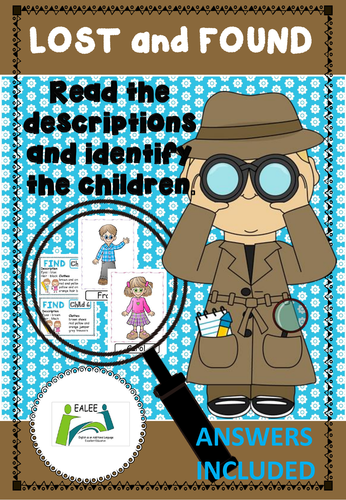

This is an engaging, deductive activity resulting in finding and matching the lost children with their descriptions. It is suitable for use with children who have the basics of reading with understanding in English. It involves reading the descriptions of twelve children and recording the identities on a worksheet. An answer sheet is included for use by teachers or to provide the opportunity for peer marking. Clothes and colour reference pages are also available for use to aid comprehension if vocabulary is unknown. This is of particular value to children who have English as an additional language. Clothes and accessories picture and word matching cards are included and could be used prior to taking part in the deductive activity to ensure familiarisation with the vocabulary to be used.
Reading, writing and deductive skills are required for the worksheet completion. If the activity is done as pair work or group work, speaking, listening and interaction are also involved.
This activity is suitable for use by all Primary 2 / Primary3 children. If children have English as an additional language, using the activity with older children would also be beneficial for the learning /consolidation of English clothes and colour vocabulary.
This resource could be used by an individual, as pair work, group work or by all children who could complete individual worksheets. The total number of twelve illustrations of children and twelve find cards would always have to be provided for the worksheet completion as twelve answers are required.. If using as a class activity more duplicated illustrations and find cards would need to be provided.
Suggestions for use
• The illustrations of the children could be secretly hidden in the classroom. (while
the children are outside) The children could each be given a find
card and then play ‘Hunt the lost children’ .
• The illustrations could be pinned on walls around the classroom.
• Single illustrations could be given to each child who would then swop with
another child who has a different illustration.
An optional follow up activity could be individual pupils writing a description of one class member. The descriptions could then be redistributed randomly to the class for identification by other class members. A worksheet is included for use.
Reading, writing and deductive skills are required for the worksheet completion. If the activity is done as pair work or group work, speaking, listening and interaction are also involved.
This activity is suitable for use by all Primary 2 / Primary3 children. If children have English as an additional language, using the activity with older children would also be beneficial for the learning /consolidation of English clothes and colour vocabulary.
This resource could be used by an individual, as pair work, group work or by all children who could complete individual worksheets. The total number of twelve illustrations of children and twelve find cards would always have to be provided for the worksheet completion as twelve answers are required.. If using as a class activity more duplicated illustrations and find cards would need to be provided.
Suggestions for use
• The illustrations of the children could be secretly hidden in the classroom. (while
the children are outside) The children could each be given a find
card and then play ‘Hunt the lost children’ .
• The illustrations could be pinned on walls around the classroom.
• Single illustrations could be given to each child who would then swop with
another child who has a different illustration.
An optional follow up activity could be individual pupils writing a description of one class member. The descriptions could then be redistributed randomly to the class for identification by other class members. A worksheet is included for use.
Something went wrong, please try again later.
This resource hasn't been reviewed yet
To ensure quality for our reviews, only customers who have purchased this resource can review it
Report this resourceto let us know if it violates our terms and conditions.
Our customer service team will review your report and will be in touch.
£3.00